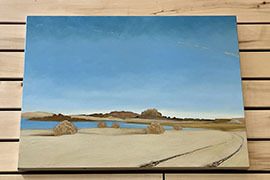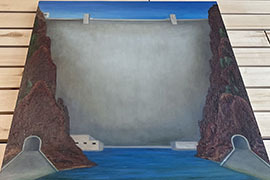- Slug: BC-CNS-River Artist,1030 words.
- Photo, audio story available (embed code, thumbnail, caption below).
By Kaya Williams
Aspen Public Radio
With his eyes squinted, hand out to the horizon, painter Patrick Kikut surveyed the scene, to translate what he saw onto paper.
Surrounded by forest greens and rusty, rocky reds, Kikut stood in a high mountain valley about an hour’s drive from Aspen. The outstretched arm was a measurement tool — a way to make sure those little trees in the distance were just the right size compared to the glassy water of Ruedi Reservoir before him.
And Kikut, who spends a lot of time these days embedded deep in river canyons, savored the summer day under his straw hat.
“I kind of come alive with more space,” Kikut said. The reservoir overlook was the site of his field drawing workshop for about a dozen people with sketchbooks. The horizon was wide, and the sky was open above him. “It allows me to catch my breath, and breathe and kind of soar a little bit.”
Kikut has been painting and drawing the landscapes of the West for decades. He traveled the region with his family as a kid and had a creative awakening in college. He found inspiration in Thomas Moran, a 19th-century artist whose paintings of Yellowstone motivated people to create America’s first national park.
“Art definitely has an important role in engaging a wider public,” Kikut said in an interview after the workshop. He looks at sites like “Artist Point,” a scenic viewing spot in Yellowstone, and sees the name as a call to action, rather than a location marker.
“I always have that in the back of my mind, ‘What is it that’s important, and what am I doing as an artist to point to things that I feel deserve some attention?’” he said.
Kikut has spent most of his career painting lonely highways and arid deserts, treating those wide and often dry empty spaces with the same reverence that Moran gave to Yellowstone.
“I’ve been documenting this drought that’s (lasted) over 20 years for — well, since it started,” Kikut said.
For most of those two decades though, water was just incidental to his subject matter. Many of those lonely highways run parallel to rivers; some of his older sketches have small puddles in them, but they’re not the focus of the piece.
Then, a few years ago, Kikut joined a team of researchers and other artists on a trip down the Green and Colorado rivers — the “original highway,” as Kikut calls it.
The journey was called the “Sesquicentennial Colorado River Exploring Expedition,” or SCREE, and it followed the same route down the Green River and Colorado River that John Wesley Powell took in 1869.
But this group’s trip, 150 years later, was shaped by major infrastructure like dams and reservoirs — and by increasingly fraught conversations about the difference between water supply and demand in the basin.
Kikut documented the trip in drawings from the field, which he later turned into larger-scale paintings.
But 2019 was a good water year. He returned last year, as reservoirs reached record lows. Now, some of his pieces inspired by the 2019 trip — as well as the return a few years later — are on display at the Basalt, Colorado, Regional Library in the Roaring Fork Valley, near a major tributary to the Colorado River.
His paintings are high up on the walls, so you have to crane your neck to see them, almost like you’re in the bottom of a canyon yourself. Dams, reservoirs and rivers come in shades of warm brown and pale blue — conveying the aridity of the Southwest’s landscapes.
“Looking at them was like, a little bit of an emotional reaction in the sense that you could really tell that he captured a moment in time,” said Christina Medved at the exhibition opening in early July. “You can almost feel how hot it was, or sense that there’s sand under his feet.”
Medved runs community outreach for the Roaring Fork Conservancy, a nonprofit that organized the field drawing workshop and collaborated with the Basalt Regional Library on this show. The paintings are on display through January.
The conservancy brings in speakers all the time to speak about water and river issues, often from the perspective of scientists, water managers and reporters. Earlier this year, they screened the documentary “A River Out of Time” about the SCREE trip, and coordinated an event with expedition leader Tom Minckley, a University of Wyoming professor.
But Medved said artists are a key part of the conversation too, especially as people try to grasp the impact of water issues that can often be complex and difficult to understand.
“We still need to be capturing these places, both for historical reasons, but also because of what they can do with drawing out the emotions and the beauty,” Medved said.
Cathy Click agrees. She used to run community engagement for the Basalt library, and this partnership was partly her idea — inspired by that screening of “A River Out of Time” in the spring.
The laws that govern our region’s rivers and reservoirs can be tough to comprehend, but Click believes art can provide an entry point.
“I mean, that’s why people make it, view it, see it, buy it — because it engages you in a completely visual way, which engages your brain to think about bigger picture things,” Click said at the exhibition opening.
Making art has the same effect, Kikut said. Painting and sketching the river helped him develop a sense of place and grasp what that place means in a larger context.
“The persistence of water, I think, is an amazing thing that allows me to think of this planet on a deeper and kind of broader scale than I have before,” Kikut said.
So now, after an extra snowy winter and rainy spring brought lots of water to the Colorado River basin, Kikut is again thinking about how it’s changing — and using his pencil and brush to depict the high water marks while they’re here.
“My images have expressed the drought and the lack of water,” Kikut said. “And it is important for me to maybe step back and think about things a little bit different. That’s as important as the next thing that’s going to come too.”
– This story is part of ongoing coverage of the Colorado River, produced by Aspen Public Radio, distributed by KUNC, and supported by the Walton Family Foundation.
For more stories from Cronkite News, visit cronkitenews.azpbs.org.
^__=
Artist Patrick Kikut showcases some of his river sketches to a field drawing workshop participant at Ruedi Reservoir in Colorado. The workshop was a collaboration with the Roaring Fork Conservancy, a nonprofit that engages in water conservation and quality issues. (Photo by Kaya Williams/Aspen Public Radio)
A painting by artist Patrick Kikut, now on display at the Basalt, Colo., Regional Library, depicts the arid environment around a reservoir. It is part of an exhibition that opened on July 7 featuring Colorado River Basin landscapes based on trips in 2019 and 2022. (Photo by Kaya Williams/Aspen Public Radio)
Patrick Kikut’s painting of Glen Canyon Dam hangs high on the wall of the Basalt Regional Library, forcing viewers to crane their necks as if they’re in a river canyon themselves. (Photo by Kaya Williams/Aspen Public Radio)


